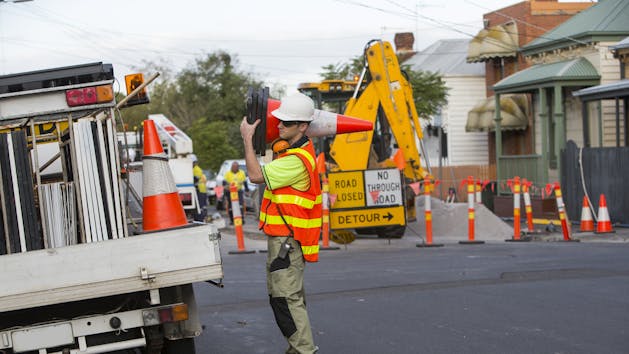Find the right solution for your business with our free Fleet Management Buyer’s Guide.
How Does GPS Tracking Report on Speeding?
It might seem like a jump for those used to only thinking about GPS in terms of identifying location, but when used as part of safe driving program and in data-gathering, telematics can be used to track and coach driving behavior. In fact, a recent survey by Verizon Connect revealed that the greater number of reports pulled using our telematics software led to an increase in improvements seen. Speeding, in particular, is just one example of unsafe driving behavior that can be addressed using this technology.
Step 1: Using GPS to calculate speed
The formula for calculating speed is speed equals distance covered divided by the time taken often represented as x = d/t.
By using two GPS points (locations) we can calculate the distance covered. We can use the clock inside the GPS receiver (a very accurate clock that synchronizes regularly with the atomic clocks aboard the GPS satellites) to measure how long it took the vehicle to travel between those two points.
In the example below the GPS receiver within the truck records its location (latitude and longitude, or lat/lon) at Point A. It takes note of the time as well. A short while later, say two minutes, it records its location again (Point B) - see below*. The GPS receiver can then perform a calculation using these numbers and determine the speed of the vehicle.
*GPS satellites send their positions to receivers on the ground every second. For the purpose of this example, we are comparing position difference over a longer period of time.
In a split second the GPS receiver will generally perform the following tasks to determine speed:
- Convert the difference between the two latitudinal/longitudinal positions into a unit of measurement (you can use online calculators to try this yourself).
- Determine the difference between the two timestamps to calculate how long it took to get from Point A to Point B.
- Calculate the average speed based on these results. For example, if the distance was three miles and the time taken was 2 minutes, then the average speed across that distance would be 90mph.
Generally, the longer the journey and the more measurements that are taken result in a more accurate, overall speed reading.
While some may argue that the speed returned by a GPS receiver is higher than the speedometer in the vehicle, most modern GPS receivers can collect speedometer readings using the OBDII port. This provides a method of verifying the vehicle’s speed.
So we know how the GPS receiver (or black box as it is sometimes called) calculates the vehicle’s speed but how does it then make its way into the Verizon Connect Fleet application reports?
Step 2: How does Verizon Connect collect GPS speed information?
The Verizon Connect Fleet application uses the GPS network to collect vehicle data. The diagram below provides an approximate overview of how Verizon Connect is connected to your vehicle’s GPS receiver.
The GPS receiver, fitted with a cellular modem, transmits data to Verizon Connect servers via the cellular network (2G* or 3G), normally every two minutes however it can be more frequent if required. The data is processed on the Verizon Connect servers and provided to Verizon Connect customers via their own secure portal, which can be accessed using any device connected to the Internet.
*2G is being phased out across the U.S. and Canada.
Vehicles may leave cellular coverage areas from time to time. When this happens the GPS receiver has internal memory to store the information that is being collected while the vehicle is out of range. When it returns to the coverage area, it sends the stored data to the Verizon Connect servers.
But how does the system work to determine if a vehicle is exceeding the speed limit based solely on the vehicle’s speed? That’s where the magic of big data comes in.
Step 3: Making sense of the data
A vehicle’s speed on its own is no indicator that a driver is speeding. But when combined with location and the known (or sometimes imputed) speed limit supplied by municipalities and other regional authorities, incidents of speeding can be highlighted in the data (normally isolated and shown to Verizon Connect users in an on-screen report).
Verizon Connect customers can choose how the data is used and presented in their reports. They can also set thresholds. Thresholds can help fleet managers weed out unwanted speeding alerts (sometimes referred to as false positives). For example, GPS signals have been known to ‘bounce’ off tall buildings momentarily creating an incorrect position for the vehicle, which results in a sudden spike in GPS speed.
By setting speeding report thresholds, such as only reporting over a specific percentage of the speed limit, or for a given duration, managers can focus on just those incidents that merit their attention.
Monitoring speeding makes a real difference
Using GPS tracking to report on speeding is more than just an intellectual exercise. It has a significant impact on reducing incidents of speeding among commercial drivers. In one example, a large fleet used information from the Verizon Connect platform to determine whether 8,000 of its vehicles were speeding. Within a year, excessive speeding incidents dropped by 90%. Even more impressive was that they stayed down.
Some reasons why Verizon Connect solutions are so effective in reducing dangerous speeding includes features such as in-cab alerts, tight feedback loops, driver scorecards (to gamify better driving), more accurate results (including custom speed limits, special speed limit zones and hysteresis (a way to verify speeding using historical data).
So it’s not enough to just collect a vehicle’s speed to reduce speeding. You need to apply some smarts to make the data actionable. Fortunately, there are solutions that do just that.
Find out how our platform gives you the visibility you need to get more done.




